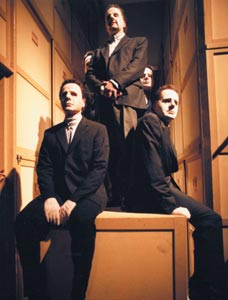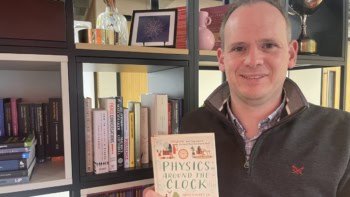Infinities
Infinities is an exciting new addition to the recent wave of plays that address “hard” science. Written by the Cambridge cosmologist John Barrow, directed by Luca Ronconi and developed in conjunction with Milan’s Teatro Piccolo and the Sigma Tau Foundation, Infinities is remarkable in its seamless merging of form and content. It gives new meaning to the concept of “science plays” through its highly visual exploration of various mathematical and philosophical postulations about infinity.
The play premiered in Milan in March 2002, moved to Valencia the following month, and was revived in Milan again this May. Performed entirely in Italian and staged in an old warehouse in Milan’s Bovisa area, where sets and costumes for La Scala productions were once kept, the play presents five scenarios on different ideas of infinity. Barrow draws on a number of writers – from Friedrich Nietzsche to Stephen Hawking – to create not so much a narrative as a set of ideas.
A huge, soaring performance space is integral to the texture of a play that deliberately rejects such mainstays of traditional theatre as plot and characterization. The vast building is divided into five separate stages of varying sizes, and the audience is admitted to a new scenario in small groups every 15 minutes. Viewers can, in principle, see the five scenarios in any order and revisit some if they wish. This makes the play infinite in its structure as it lacks a beginning, middle and end – an open-endedness that neatly captures its thematic core. Although some scenarios work better than others, Infinities offers a new experience for actors and audience alike, in which the language of drama and the language of science spectacularly meet.
The first scenario – “Welcome to the Hotel Infinity” – dramatizes a famous mathematical thought experiment. At Hilbert’s Hotel, an overwrought manager with an infinite number of rooms must accommodate increasing numbers of guests in increasingly complex numerical arrangements, from one new guest to whole galaxies of new arrivals. The actors explain the complex mathematics with the help of a huge monitor displaying the equations necessary to work the solutions out. With tongue only slightly in cheek, Barrow concludes with a cosmological moral: if the universe is infinite and began from nothing, maybe it will one day return to nothing after it gets too complicated and unmanageable to keep it running any more.
The audience’s next stop – if viewers choose to see each scenario in order – is about living forever, and is staged in a black box full of impossibly old people languidly reading while sitting in their wheelchairs or under hairdryers. The stifled atmosphere and long monologues create a sense of monotony that effectively emphasizes the idea of perpetuity and shows how oppressive it would be to live forever.
The third scenario is, by contrast, a tour de force, dramatizing Jose Luis Borges’ parable of the Library of Babel – a metaphorical universe containing book after book in endless hexagonal galleries. Visually inventive staging – involving the use of mirrors at the ends of several corridors lined with drawers that are large enough to hold a human body – creates the illusion of an infinite library. The audience is invited to wander from corridor to corridor, while the voices of the actors resound around them, and we suddenly notice that these actors are all identically masked and clothed. With the dialogue suggesting the impossibility of uniqueness and individuality, a disturbing effect is achieved by having the actors endlessly replicated.
After a fourth scenario dramatizing the conflict between the 19th-century mathematicians Cantor and Kronecker about the nature of infinity, the audience enters another gigantic open space for the final scenario, which is about time travel. A grandmother teeters across the stage, narrowly missing her grandson speeding towards her in his wheelchair – thereby illustrating the “grandmother paradox” by which you logically cannot go back in time and kill your grandmother or shoot yourself as a baby. The concept of time travel is made real through the use of a train car complete with dining passengers and seats facing in both directions, as if to suggest literal conveyance between epochs on so ordinary a time machine as a train.
These are some of the director’s few concessions to audience expectations of realism. Ronconi prefers to rely on more abstract elements such as symbolic movements that suggest infinity: straight lines (actors moving perpetually forward and backward) or circles (actors sitting or walking endlessly around). Although each scenario is distinct in style and substance, the thread connecting them all is, of course, the concept of infinity. Certain visual elements do, however, provide continuity as well, such as the use of mostly black costumes with startlingly white faces wearing white half-masks – leaving the mouth and eyes visible but grotesquely exaggerating the cheeks and nose.
Infinities places exhaustive demands on its large cast, which is made up of at least 12 professional actors plus dozens of student “extras”. They often have to rush from one scenario to another and take turns rotating roles throughout the run of the show to avoid becoming complacent and predictable. There is a great deal of complicated text for the actors to memorize, yet no linear plot and no characterization. The actors are constantly moving, whether crossing the stage hanging upside down from a thin metal track or leaping across a vast expanse of books, and they need to be almost acrobatic and have great stamina to perform these feats.
There is little comic relief in the play. Indeed, audience members seemed to be concentrating very hard on the ideas during the performance that I attended. But the serious faces may also have been due to the vulnerable position that Ronconi deliberately puts us in: we are left as visible as the performers, who move among the viewers and address us directly. Most interesting is the unfamiliar territory we get to explore – both in terms of ideas and in the kind of theatre performed here. Whether or not the audience (or indeed the actors) fully understands the ideas in the play is not the point. What is important is the feeling of having been briefly and intensely immersed in these ideas and having shared them with fellow spectators and the actors.
The play has been well received in Italy and Spain, but there are no firm plans as yet to produce it elsewhere, mainly because it seems so organically tied to the space in Milan, where it originated. Still, the spatial requirements and the need for so many professional actors should not prevent its performance elsewhere. Surely some comparably vast site could be found for its English-language premiere – perhaps London’s Millennium Dome? – so that audiences outside Italy and Spain can see a play where the stunning combination of mathematics, philosophy and the resources of live theatre is exhilarating and unforgettable.




